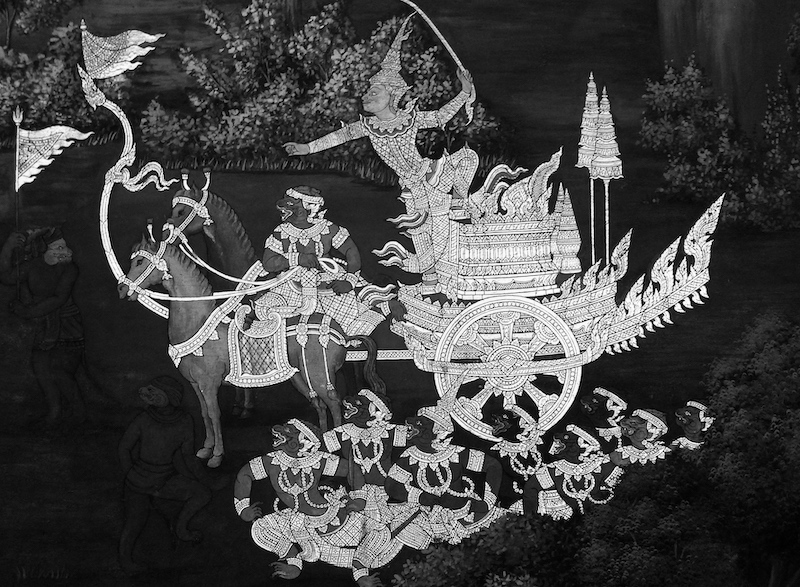
Ramakien is the Thai-language rendition of the Indic tale of Rama, a god born into a royal family and tasked with upholding moral virtue. The frame story of abduction and battle is modeled on the Indian Ramayana by the poet Valmiki, but there are many differences in tone and character. These extracts are from the version completed in 1798 at the court of King Rama I (r. 1782–1809), founder of the still-reigning Chakri dynasty. There are other renditions in Thai, both earlier and later, but this is the most famous and by far the longest, having likely incorporated all tellings of the tale in Thai known at that time. The original text is labeled a “drama script” and has music cues and stage directions. Episodes are still performed in the dance-drama form of khon with elaborate costumes and color-coded masks to identify some of the main characters, as well as being performed using puppets and other ways. The original is written in verse form with multiple rhymes and other constraints, but this translation is in prose.
Readers should note that the names of leading characters may vary. Phra Ram (Rama) is sometimes called Phra Narai, referring to his origin as an avatar of Vishnu, or by some honorific: Phra Chakkrit, Chakri, Kritsanu, Hariwong or Harirak. Nang Sida (Sita) is sometimes called Phra Laksami, the consort of Vishnu and the Hindu goddess of wealth and beauty. The Ravana character in the Indian versions is here called Thotsakan, literally meaning “ten-necked,” referring to his characteristic ten heads and faces, and sometimes as Rapphanasun. His followers may be called asura, kumphan, or yaksa. Hanuman and other monkey troops who fight on the side of Phra Ram are sometimes referred to as wanon or krabi.
The first extract, “Abduction of Nang Sida,” is the famous scene that triggers the conflict between Phra Ram and Thotsakan, the conflict that forms the major part of the story.
The second extract, “Suphanamatcha,” comes when Phra Ram is building the causeway to take his army across to the island of Longka, the home of Thotsakan, and recover Sida who has been taken there by Thotsakan. The episode showcases the distinctive character of Hanuman in the Thai Ramakien as both a superhero and a flirtatious womanizer. This scene is often performed, particularly the dance sequence when Hanuman chases Suphanamatcha, the mermaid daughter of Thotsakan.
The third extract, “Hanuman Carries the Mountain to Cure Phra Lak,” occurs during the many battles between the two sides. An army led by Phra Ram’s younger brother, Phra Lak, has been defeated by an army led by Thotsakan’s son, Intharachit, who used some subterfuge. The episode is well known through the image of Hanuman carrying a mountain through the sky. Today this scene is perhaps the most performed of the entire epic, given its grand imagery and exciting events.
The translation is by Frederick Goss and was edited by Christopher John Baker, a Thailand-based writer and the coauthor, with Pasuk Phongpaichit, of A History of Thailand (Cambridge University Press, 2014).
